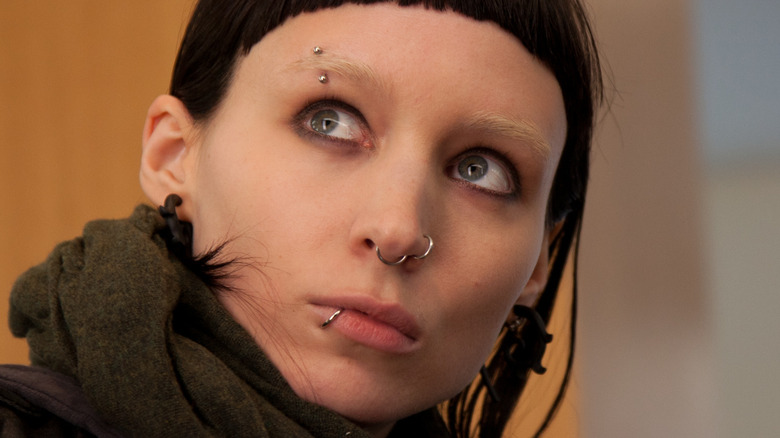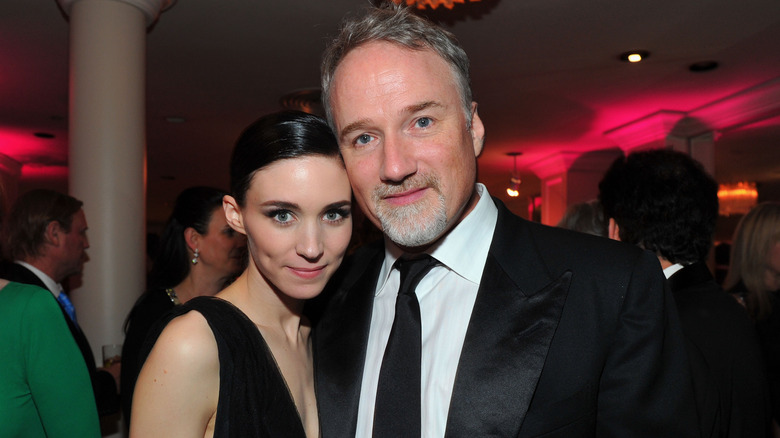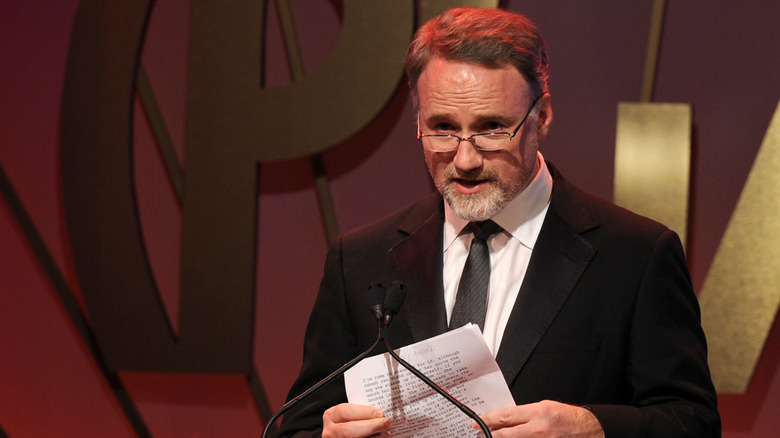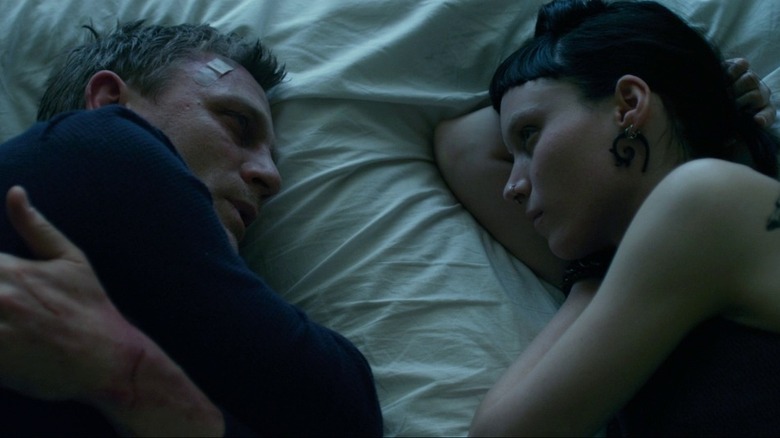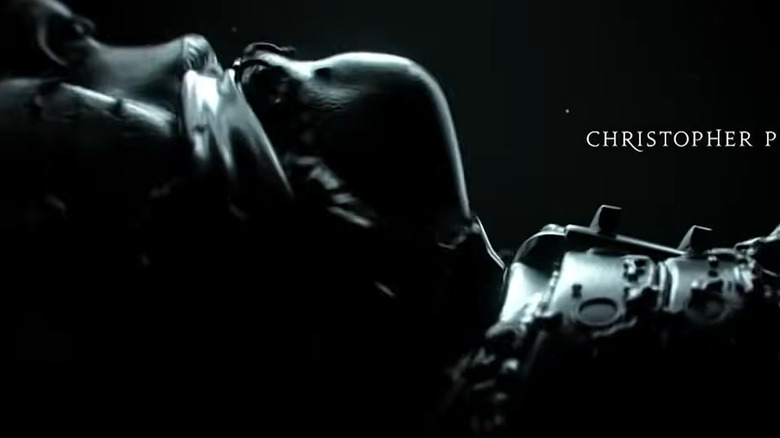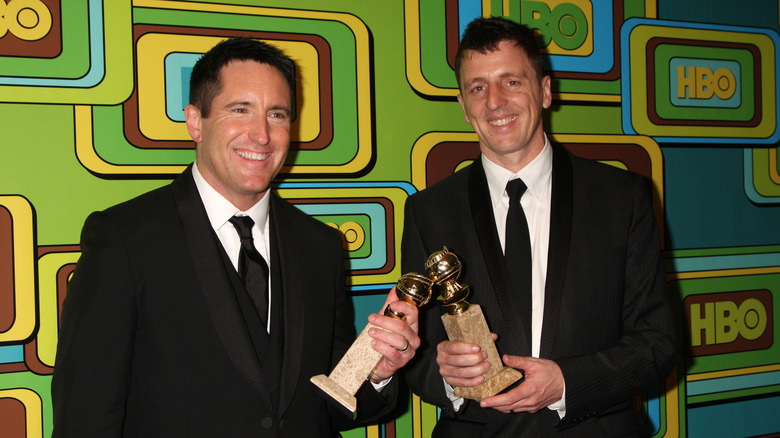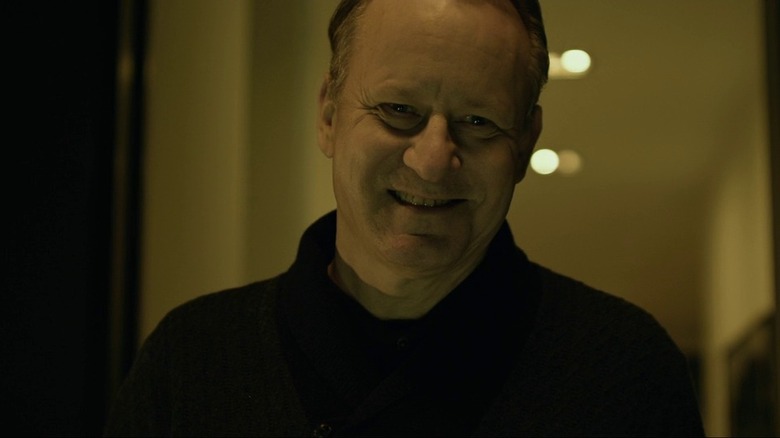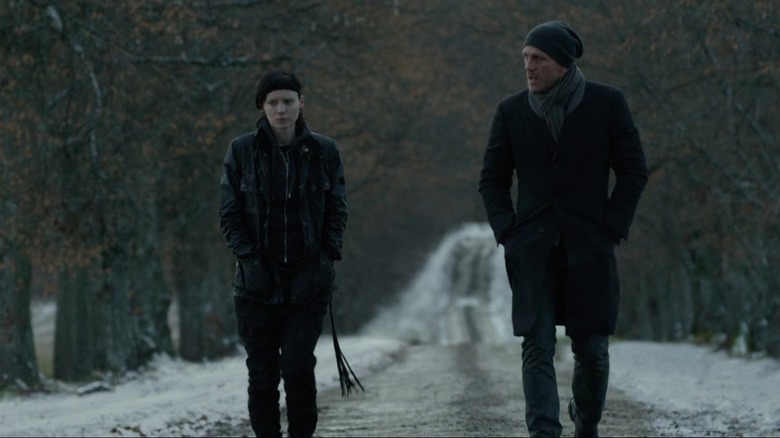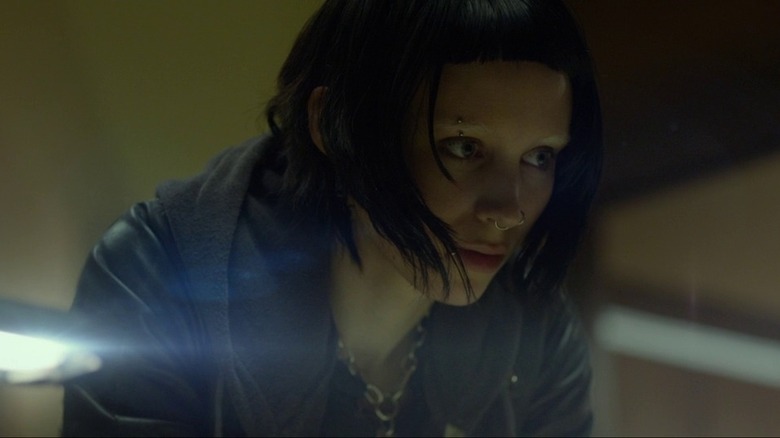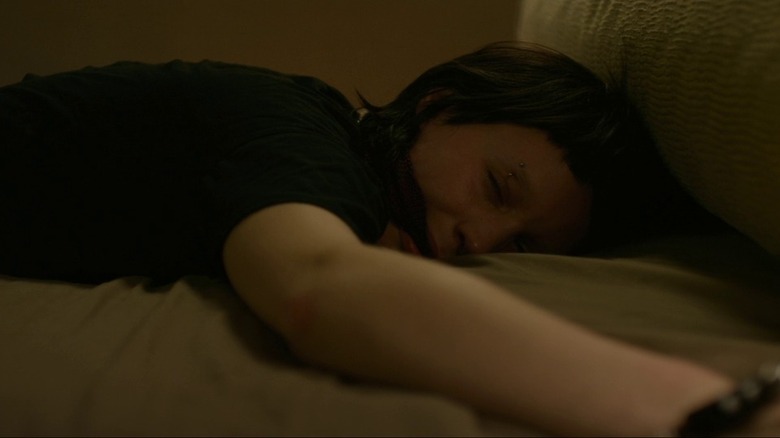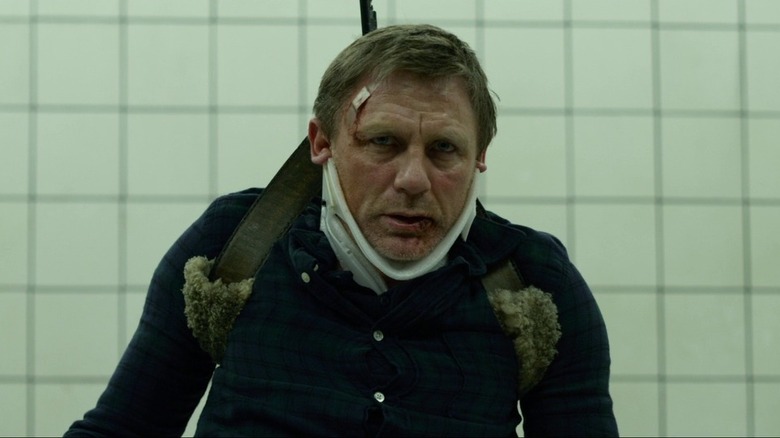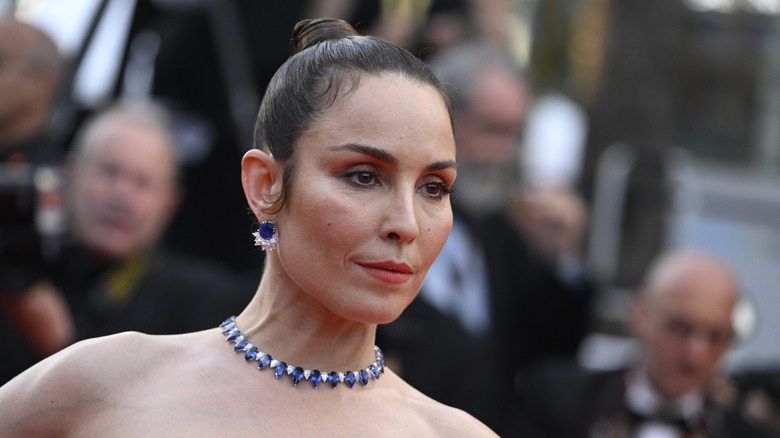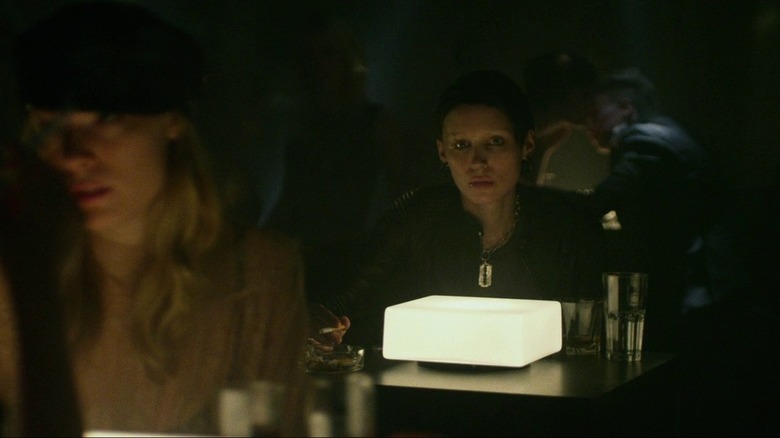The Girl With The Dragon Tattoo: What Only Huge Fans Know About Fincher's Hit Movie
Over the years, there's been much discussion about American remakes of international films. Are they really necessary? Can't American audiences just read the subtitles? There are certainly plenty of valid criticisms of the trend, and it tends to uphold the idea that Hollywood executives are driven by money above all else. But there's at least one exception to the rule, the kind of film that makes you forget that anything ever came before it. David Fincher's "The Girl With the Dragon Tattoo," the American adaptation of the Stieg Larsson bestseller, is one such film.
Fincher is well-known for his exacting eye and the way his films build a unique and all-encompassing atmosphere, and "Dragon Tattoo" is no exception. Rooney Mara's performance as Lisbeth Salander is utterly spellbinding, and Daniel Craig is surprisingly well-suited for the role of everyman Mikael Blomkvist. Under Fincher's deft directorial hand, the film brings to life a sleek, sinister world that is difficult to look away from, even though at times the viewer might want to.
The film is so beautifully crafted and filled with such sharp performances that the countless hours of work that went into its creation seems unimaginable. But if you're as curious, keep reading to learn many of the secrets behind Fincher's "The Girl With the Dragon Tattoo."
David Fincher put Rooney Mara through several trials during the audition process
Whenever a big project is cast, a lot is made of the names considered for the part — and with "Tattoo" already a bestseller book that everybody seemed to be reading in the mid-'00s, there were plenty of opinions about who was right and who was all wrong.
To land the part of Lisbeth Slander, Rooney Mara went up against such actors as Mia Wasikowska, Elliot Page, Emily Browning, Scarlett Johansson, and Natalie Portman. But what's more interesting about the casting process is not who was initially up for the part, but what Rooney Mara had to go through to eventually secure the role.
According to the film's production notes, the audition process was extensive, with Fincher asking Mara to do things like recite Swedish poetry and climb on motorcycles. Mara told Collider in 2011 that Fincher once told her "Go out and get really, really drunk and come in the next morning so we can take pictures of you." He wanted to prove to the studio that she could look exhausted and on edge. "And I did it!" She explained. "Threw up all night!"
All in all, Mara told Charlie Rose, the audition process took about two and a half months. Fincher worked with Mara briefly on "The Social Network," where she played Mark Zuckerberg's girlfriend in a memorable scene, but that part had essentially nothing in common with Lisbeth Salander. What eventually convinced him was her determination.
"Finally, it became apparent to me that she was not going away, not giving up," he told the Hollywood Reporter. "She was going to do what needed to be done, and that was very Salander-ish."
Production coincided with awards season, creating scheduling problems
Being the well-respected filmmaker that he is, Fincher's schedule can get pretty busy. In the case of "The Girl With the Dragon Tattoo," the success of Fincher's previous film was what made the scheduling process hectic. As pre-production began on "Tattoo," "The Social Network" had premiered and quickly become an awards season favorite. After a month of prep work in Sweden, Fincher had to fly back to the states for an awards ceremony before heading right back to Sweden to begin filming.
Fincher wanted all the people who had worked on "The Social Network" to be properly recognized, but he also had his new movie to think about. "I was extremely happy with the response people had to 'Social Network' and wanted to see everyone who was decorated get their just desserts. I didn't want to be sleeping in airports for seven to eight weeks, but that's what it ended up being," he told the Hollywood Reporter.
After filming wrapped in Sweden, production relocated to a sound stage in Los Angeles, which happened to coincide with the Oscars that year. There was no rest for Fincher, as the cast and crew had a call time of 6 AM while the after-partying was still winding down. "The Social Network" wound up winning three Oscars that year, while "Dragon Tattoo" went on to win one award in addition to four other nominations.
The screenwriter was given free rein with the script
Stieg Larsson's 2005 bestseller is a 600-page-long psychological thriller and mystery, and one would imagine adapting it into an English-language film would be no small feat. The film's script was written by Steven Zaillian, and Fincher told the Hollywood Reporter his initial reaction to hearing it would be adapted. "I was just wondering what 350 pages Zaillian would get rid of," Fincher said.
It was certainly a daunting task for Zaillian, but, as he told The Guardian, there was less pressure than one might expect. The novel is quite brutal in its depiction of violence, and the film isn't any less severe. The studio didn't want Zaillian to soften any elements of the book, because, as he tells it, "they understood that part of the reason the book is so successful is because it doesn't tiptoe around those issues." Zaillian shared that he was essentially given free rein in adapting the novel, as the studio hardly even briefed him on their expectations. The only stipulation they had was that it be set in Sweden, not the United States.
There are several differences between the novel and the film, most notably the twist at the end. Zaillian did his best to block out the fact the book was a huge success, beloved by millions, instead focusing on telling a good story. "I didn't change anything just for the sake of changing it," he explained.
The title sequence represents Lisbeth's nightmares
One of the most talked about parts of "The Girl With the Dragon Tattoo" is its title sequence, which is a piece of art itself. The sequence was done by Tim Miller, co-founder of an animation studio called Blur (and eventual director of "Deadpool").
Miller told Gizmodo in 2012 that the sequence was meant to represent Lisbeth's nightmares. "David wanted this to be her personal nightmare, flashbacking through all these moments," he explained. It was important Lisbeth's hacker vocation be included in the sequence, which is why a keyboard is seen near the beginning, along with what Miller calls the "primordial dream ooze."
There are also several references to the book sprinkled throughout the sequence. Miller and his team designed Lisbeth's tattoos, several of which are featured in the title sequence. This includes her wasp tattoo, which is referenced in the third book, "The Girl Who Kicked the Hornet's Nest." There's also a sequence where Blomkvist is covered in pieces of newspaper, which represents him "trying to speak the truth and the establishment is forever smothering him."
The sequence is soundtracked by a cover of Led Zeppelin's "Immigrant Song," with Yeah Yeah Yeahs lead singer Karen O singing the vocals. Fincher told Gizmodo he knew he wanted the track to have a female singer, and he envisioned the song as "Lisbeth's battle cry."
Trent Reznor and Atticus Ross started composing the score before the film was completed
The score for "The Girl With the Dragon Tattoo" was composed by Trent Reznor and Atticus Ross, who had worked with Fincher before on "The Social Network" (and won an Academy Award for their efforts). What was different between those two projects, the Nine Inch Nails frontman told The Film Stage, was the order of operations. While they scored "The Social Network" after the film had already been completed, "Dragon Tattoo" was scored while the film was still in production.
They began thinking about the project before there was even a script, having talked with Fincher about what the general atmosphere would be like. "We just blindly composed for six weeks this time last year," Reznor explained. Fincher had begun filming at that point, so Reznor and Ross would send him what they had been working on to see if he liked it. Usually, rough edits are scored by temp music, but because Reznor and Ross had already begun working on the score, Fincher had the luxury of using their music in the edit from the beginning.
But what was difficult about composing the score in this way, Reznor explained, was that there wasn't a set structure and chronology they were working around. It was frustrating that things kept changing, but they learned to work in this new environment. "It was a lesson we learned pretty quickly of, "Everything is in flux, and approach it as such. Hopefully it'll work out in the end."
Daniel Craig chose the famous Enya song
"The Girl With the Dragon Tattoo" is a memorable movie for a lot of reasons, but there are few scenes as enduring as the one where a particular Enya song plays. If you've seen the film, you'll surely recall it. Martin (Stellan Skarsgård) has tied up Blomkvist (Daniel Craig) in his basement and is preparing to torture him. But first, he has to set the tone, so he puts on some torture music. His song of choice? "Orinoco Flow" by Enya, also known as the "Sail Away" song.
It's an amusing choice, and fans have Daniel Craig to thank for it. "We knew that we needed a little moment of levity," Fincher told Entertainment Weekly in 2011. "Daniel Craig hopped up and picked up his iPod and scrolled through it and said, 'Here it is.' And we all almost pissed ourselves, we were laughing so hard."
The song is certainly not what comes to mind you imagine one associated with torture or violence, and that's exactly what made it the perfect choice. "It's not like it's part of the serial-killer playlist on iTunes," Fincher joked.
The original cut of the film will never see the light of day
"The Girl With the Dragon Tattoo" already clocks in at a respectable two hours and thirty-eight minutes, but, according to Fincher, the original cut was even longer. He told Collider it was "three hours and seven minutes" long, to be exact.
Discussing his decision to cut over twenty minutes from the film, Fincher explained "Somebody asked me, 'At what point did you decide the movie should be two hours and thirty three minutes?' And I said, 'At the point in time where it was three hours.'" Though Fincher was happy with what they had captured, he "didn't think we could sustain three hours worth of interest."
When asked if he would ever release the original cut of the film, Fincher said "No, I don't believe in that." He maintained that the final cut of the film should be the final cut and that he would never go back and revisit any of his old films to see if they could be reworked. Fincher is also in the unique position of having final cut on his films, which, as he told First Showing, he's had since he worked on "Panic Room."
That means that when Fincher cuts something from one of his films, he truly believes it should be cut. "There were moments that I would have wanted to have had, but it either killed the pace of the thing or it gave you an impression that the movie was starting again. I'm happy with this version of it," he explained.
Rooney Mara got real piercings for the part
From a visual standpoint, one of the most eye-catching parts of "The Girl With the Dragon Tattoo" is Rooney Mara's transformation into Lisbeth Salander. She has several different hairstyles throughout the film — all of which are quite extreme — as well as numerous tattoos and piercings. Describing the process of putting on the fake tattoos, Mara told Entertainment Weekly in 2011 that "It was really easy. It's called a transfer. It's kind of like the kind you get when you're a little kid, but instead of water you use alcohol to put them on."
Mara was fully committed to the role — which, in this case, meant she went out and got some of the piercings herself. According to the film's production notes, Mara got her eyebrows bleached and her eyebrow pierced that same day. The piercings on her eyes and her nipple were also real, because nipple piercings are quite difficult to replicate. Mara told Digital Spy that she "was happy to do the piercings," and what she learned was that "the fake ones were actually more painful than the real ones."
Of the process, hair and makeup designer Torsten Witte recalled "I would often feel so bad meeting Rooney at 4:30 in the morning to cut, shave, bleach and tattoo her." The whole team was impressed by Mara's commitment to the total transformation, and the effect of all this hard work is readily apparent in the final product.
Rooney Mara was left with bruises after one difficult scene
"The Girl With the Dragon Tattoo" is filled with brutal scenes, undoubtedly difficult to shoot. Fincher is known for excelling at such dark themes, but he is also known for insisting upon a lot of takes, which makes for long days on set. Speaking with Cinema Blend in 2011, Mara explained that one of the most difficult scenes to film was not the rape scene, but the one just before that, where Lisbeth is being choked.
Because it was such a difficult scene to shoot, they tried to do it as quickly as possible. "David came up to us before that and said "I'm going to try and do this six times," Mara explained. "We did it much more than six times, but we all went in knowing there was a limited amount of takes we could get at that."
The scene in particular took a toll on Mara physically. She recalls coming home that evening and the person who greeted her thinking she had makeup on when it was really just actual bruises from filming. "I was really getting choked out. You can't really fake that — we weren't faking that," she said. In a dark twist of fate, Mara told Entertainment Weekly that the entire rape scene was done in a week, and it happened to be the week of Valentine's Day.
If you or anyone you know has been a victim of sexual assault, help is available. Visit the Rape, Abuse & Incest National Network website or contact RAINN's National Helpline at 1-800-656-HOPE (4673).
Daniel Craig passed out for real during the torture scene
Rooney Mara may have had to film some harrowing scenes as Lisbeth Salander, but Daniel Craig wasn't spared from the violence either. In one of the most famous scenes in the film, Craig's Blomkvist is restrained and then strung up by Martin in his basement.
It's an intense scene, and Fincher told Collider that there were certain safety measures put into place. "The first night that we got to the hoisting and the stunt coordinator came in and said, 'Daniel has to hold this little metal thing in his hand so that if he does lose consciousness ...' Because he's gonna be acting like he's suffocating, which is not very different from actually suffocating ...," he explained.
The stunt coordinator was right to be concerned, because Craig actually did wind up passing out while they filmed the scene. "On the production report was 'Let Daniel go 15 minutes early due to unconsciousness,'" Fincher joked. When asked what he thought about the experience, Craig simply responded "Just another day working with David Fincher."
Rooney Mara never spoke with Noomi Rapace about her take on the role
David Fincher's "The Girl With the Dragon Tattoo" may be the most popular adaptation of the novel among American audiences, but it's not the first filmed version of Stieg Larsson's novel. The Swedish version of the film — starring Noomi Rapace — came out in 2009, and was followed by two sequels.
In an interview timed to the film's release, Mara noted that she saw the first Swedish film, but that was before she knew she was going to play the role. Mara went on to praise Rapace's performance in the film, but noted "as soon as I'd read the books myself, and as soon as I'd got the part, I couldn't think about it again. We didn't use the Swedish movies as a reference point or discuss them on set. We just always went back to the books."
Mara shared that though she has met Rapace, it was only very briefly, and they never discussed their shared role. She told said in 2011 that she wouldn't have wanted to discuss the role with Rapace had she gotten the chance: "Her performance is really brilliant, but the idea of the character that I had was much different."
The average number of takes done for each scene is less than you think
Like Stanley Kubrick (who once reportedly made Tom Cruise walk through the same door frame 95 times for "Eyes Wide Shut"), Fincher is known for being a perfectionist, in unrelenting pursuit of capturing the precise image he sees in his mind. Often, it is the actor who suffers, but the audience who is ultimately rewarded.
Fincher supposedly filmed as many as 99 takes of the famous scene in "The Social Network" where Rooney Mara's character breaks up with Mark Zuckerberg; Mara, however, isn't sure if that's the truth.
"That's what they told me, but then I've also heard that that was just a joke and not true," she told the Hollywood Reporter in 2011. "It was a six-page scene, and we shot it over a day-and-a-half or two days, so, you know, 99 takes actually isn't that unreasonable if you think about it."
While speaking with the cast, Charlie Rose asked if they filmed "100 takes" of every scene, which prompted much laughter. "That's a fallacy," Craig responded; later, speaking with Interview Magazine, Fincher and Mara discussed Fincher's style of filming.
"I think people like to exaggerate about the number of takes you do," Mara chimed in when Fincher brought up the idea of doing a scene seventeen times, to which Fincher added: "I'm going to find out exactly what our average number of takes was."
The truth? At least, according to Interview Magazine, "The average number of takes for any scene on The Girl With the Dragon Tattoo was seven."
